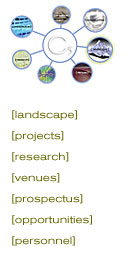 |
Autopoietic Data Systems Organization
![]()
Geri Wittig
An explosion in data generation and collection in the wake of ongoing developments in digital
technologies necessitates investigation into new techniques and processes that can intelligently
and automatically aid in translating this data into useful knowledge. Novel and thoughtful
juxtapositions of conceptual approaches are needed to help enrich and inform the growing
interdisciplinary fields of Knowledge Discovery and Data Mining.
One such area of investigation that offers significant potentiality for meaningful and productive
development in the field of Knowledge Discovery in Databases (KDD) is autopoiesis, a form of
system organization where the system as a whole produces and replaces its own components and
differentiates itself from its surrounding environment on a continual basis. Principles of
autopoiesis, such as structural coupling and consensual domains, which are rich in organizational
concepts, have potential applicability in KDD research and the 16 Sessions project offers a
non-traditional approach to investigation into this endeavor.
It is the ontogeny of the 16 Sessions project that is the starting point for this investigation.
Ontogeny, as defined by Maturana and Varela, is "the history of structural change in a unity
without loss of organization in that unity"; ontogeny is of primary concern in autopoietic systems
analysis. Continual structural change takes place in a unity, either through external interactions
from the environment or through its own internal dynamics. The ontogenic transformation of a
unity desists only with its deterioration. The seminal factor in the ontogeny of the16 Sessions
project was data collected in the Not to See a Thing installation by Joel Slayton, presented in
the exhibition, Alternating Currents: American Art in the Age of Technology, at the San Jose
Museum of Art. During the run of this exhibition, motion data (x, y, z and orientation) was
collected through audience interaction, resulting in an extensive database in which emerged a
series of data agencies and data attributes. Data agencies with their categorical tendency and
data attributes, which are linguistic behaviors, possess language-like qualities. These data
agencies and attributes were applied to a proprietary Mesh database of validated http IP addresses
under development at C5. The data has been reduced and Mingling algorithms have been developed,
so the users network identity can generate "feelers" into potential information relations.
Such relations can then be collapsed into structural couplings, which are both arbitrary and
contextual.
In a structural coupling, interactions between a unity and another unity, or the environment,
will consist of reciprocal perturbations. In these interactions, the structure of the environment
only triggers structural changes in autopoietic unities, it doesn't determine or govern them,
and vice versa for the environment. Mingling, the bringing together of components in close
association, is a mechanism which seems particularly suited to enabling structural coupling,
in that mingling usually, but not always, suggests no fundamental loss of identity.
The 16 sessions mingling algorithm is a linear data visualization routine that includes the
influence of the mingler's network identity in the final output. The algorithm uses the mingler's
network identity in its internal data smoothing operation, after which the data is released into
an abstract environment in which its agencies and attributes (expressed solely through their
language-like behavior without any intervention) are determinant of the data's structural coupling
with the space. The perturbances generated between data and environment generate "feelers" into
potential information relations - potentially interconnected patterns of behavior that form a
consensual domain.
Autopoiesis as related to data, could potentially be realized in linguistic, consensual domains.
Language, as a consensual domain, is a patterning of behavior that possesses a shared orientation.
When an observer operates in a linguistic domain, as in the 16 Sessions project, they operate in a
domain of descriptions - or agencies and attributes. An observer makes linguistic distinctions of
linguistic distinctions - ontogenically generated descriptions. Observing emanates with language
as a co-ontogeny in the process of delineating. The observer is a languaging entity, operating in
language with other observers, generating linguistic distinctions in a linguistic domain. Meaning
or knowledge discovery emerges as a relationship of linguistic distinctions. Patterns of recurrent
interactions or minglings make possible ontogenic structural drift in a structural coupling, that
affords coordinations of actions specified through our data minglings.
Bibliography
Maturana, Humberto and Varela, Francisco. The Tree of Knowledge: The Biological Roots of Human Understanding.
Boston: Shambhala Publications Inc., 1987.Flores, Fernando and Winnograd, Terry. Understanding Computers and Cognition: A New Foundation for Design.
Norwood, NJ: Ablex Publishing Corportion, 1987.Indurkhya, Nitin and Weiss, Sholom. Predictive Data Mining: A Practical Guide. Morgan Kaufman Publishers, 1997.